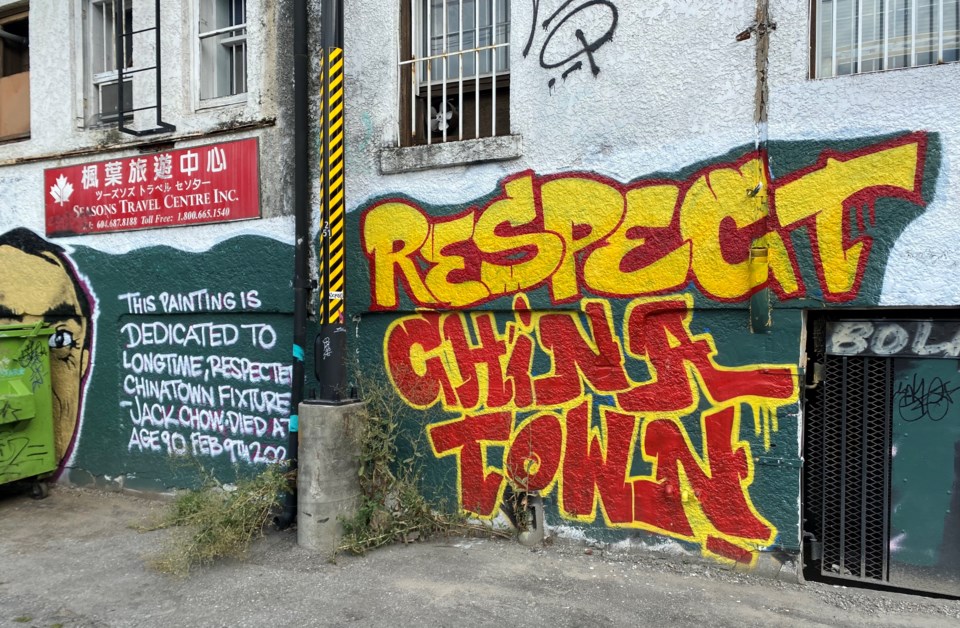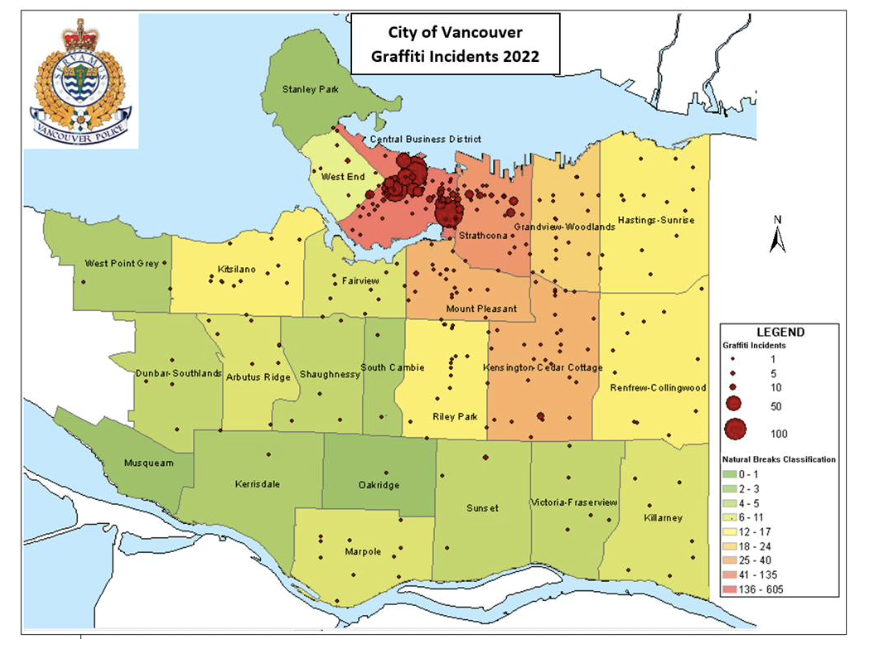Vancouver police have released a map of the city that shows which neighbourhoods were hit hard by nuisance graffiti in 2022.
Residents and business operators in downtown and Chinatown — who have previously addressed city council over the noticeable increases in graffiti — will not be surprised to learn their neighbourhoods were the most targeted.
“I see it every day,” said Jordan Eng, president of the Vancouver Chinatown Business Improvement Association. “And we — the BIA — we're paying for the cleanup, and it affects each of the business owners who are all paying for it directly or indirectly through their BIA levy.”
Chinatown alone saw a 310 per cent increase, from an average of 38 incidents between 2017 and 2019 to 157 last year, according to police data in a report that went before the Vancouver Police Board Feb. 23.
The central business district generated 605 reports in 2022 of what police described as “graffiti mischief incidents.” In 2021, the same area generated 306 reports and 257 in 2020, the police data shows.
Strathcona (87 reports) and Kensington Cedar-Cottage (39) were two other neighbourhoods police included in the data, showing 125 per cent and 72 per cent increases, respectively.
Mount Pleasant (31) and Grandview-Woodland (24) showed slight decreases, although the data is generated by reports and not someone actively counting each time property is tagged, which occurs regularly throughout the city and is not reported.
Overall, the number of reports recorded by police totalled 945 across the city, up from 654 in 2021 and 718 in 2020; graffiti reports through 2017 and 2019 did not exceed 400.
6,400 graffiti complaints to city's 311 service
Those statistics, however, do not include calls from residents to the city’s 311 phone service.
Council heard from staff last summer that graffiti spiked across the city since the pandemic was declared in March 2020: a total of 6,400 case files were created in 2021 for graffiti complaints logged by the city’s 311 operators.
The city’s graffiti removal contractor, Goodbye Graffiti, which is responsible for painting over graffiti on city buildings, property and infrastructure, removed more than 150,000 tags in 2021, an increase of 49 per cent from 2019.
The city also saw a significant increase in the amount of free paint it distributed to Vancouver property owners and tenants, who can receive up to two gallons of exterior paint in a calendar year for graffiti removal.
In 2021, the city handed out 335 gallons of paint — an increase from 240 gallons in 2020 and 175 gallons in 2019.
Back in June 2022, city council approved $500,000 for 22 business improvement associations to tackle graffiti in their neighbourhoods and committed another $20,000 to artists, non-profits and others to assist in reducing tagging on private and public property.

Smokey Devil
The $20,000 commitment was not included in city staff’s recommendation but was added after council heard from Downtown Eastside artist Trey Helten about the art and outreach that he and Jamie Hardy (also known as Smokey Devil) were doing in Chinatown.
Helten told council that he and Hardy have used their own money to paint murals in Chinatown and are working with business owners to reduce the widespread graffiti that has plagued the historic community.
Eng said it was important to make the distinction between nuisance graffiti and art.
“I guess there is definitely a line in the sand where the graffiti artists are quite different from the taggers,” he said. “Trey and Smokey have been very supportive of Chinatown. And that's part of being in a community where you're trying to support each other.”
For Hardy's community service, Mayor Ken Sim has proclaimed March 11 as "Smokey D Day," honouring him with a proclamation that calls the artist a "bridge builder "between the Downtown Eastside and Chinatown.
'Uplifting Chinatown'
In January, city council unanimously approved spending $700,000 on the “uplifting Chinatown action plan,” which aims to better conditions in a community hit hard by the pandemic and its negative effect on residents and businesses.
Graffiti removal strategies for public and private property, more cleaning and sanitation services and litter and needle collection are included in the plan, which Coun. Sarah Kirby-Yung inspired via a motion last year to council.
“I still do hear reports of some graffiti,” Kirby-Yung said Thursday. “I don't have stats at my fingertips to see if it’s gone up or down in the last month. I’m not necessarily hearing that it's increasing. I'm just not hearing how much it's been alleviated yet.”
As Glacier Media has previously reported, Chinatown saw an increase in anti-Asian hate crimes in the early days of the pandemic. Violent attacks on citizens, an increase in broken windows and a downturn in business has also occurred in the community.
"Chinatown is an invaluable part of our city — a much-beloved community that celebrates Vancouver’s diversity and cultural heritage," Mayor Ken Sim said in a news release in January.
"Chinatown holds an important place in the hearts of many. With the passage of the Uplifting Chinatown Plan, we are excited to be taking the next step towards the revitalization and renewal of this vital part of our city."




